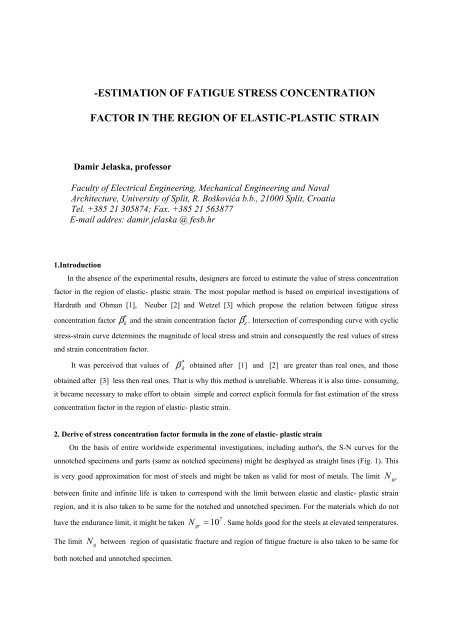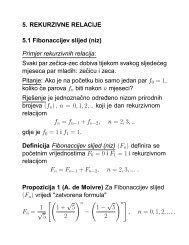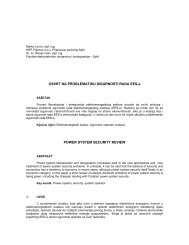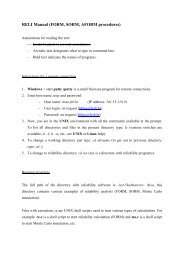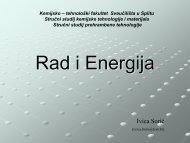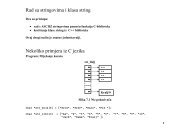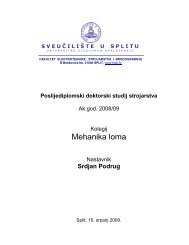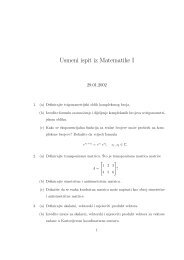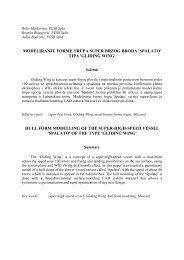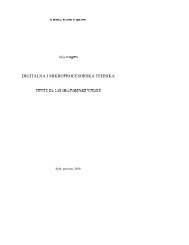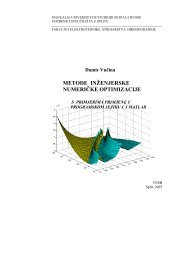ESTIMATION OF STRESS CONCETRATION FACTOR - FESB
ESTIMATION OF STRESS CONCETRATION FACTOR - FESB
ESTIMATION OF STRESS CONCETRATION FACTOR - FESB
You also want an ePaper? Increase the reach of your titles
YUMPU automatically turns print PDFs into web optimized ePapers that Google loves.
-<strong>ESTIMATION</strong> <strong>OF</strong> FATIGUE <strong>STRESS</strong> CONCENTRATION<br />
<strong>FACTOR</strong> IN THE REGION <strong>OF</strong> ELASTIC-PLASTIC STRAIN<br />
Damir Jelaska, professor<br />
Faculty of Electrical Engineering, Mechanical Engineering and Naval<br />
Architecture, University of Split, R. Boškovića b.b., 21000 Split, Croatia<br />
Tel. +385 21 305874; Fax. +385 21 563877<br />
E-mail addres: damir.jelaska @ fesb.hr<br />
1.Introduction<br />
In the absence of the experimental results, designers are forced to estimate the value of stress concentration<br />
factor in the region of elastic- plastic strain. The most popular method is based on empirical investigations of<br />
Hardrath and Ohman [1], Neuber [2] and Wetzel [3] which propose the relation between fatigue stress<br />
concentration factor b k * and the strain concentration factor b e * . Intersection of corresponding curve with cyclic<br />
stress-strain curve determines the magnitude of local stress and strain and consequently the real values of stress<br />
and strain concentration factor.<br />
It was perceived that values of<br />
β k<br />
*<br />
obtained after [1] and [2] are greater than real ones, and those<br />
obtained after [3] less then real ones. That is why this method is unreliable. Whereas it is also time- consuming,<br />
it became necessary to make effort to obtain simple and correct explicit formula for fast estimation of the stress<br />
concentration factor in the region of elastic- plastic strain.<br />
2. Derive of stress concentration factor formula in the zone of elastic- plastic strain<br />
On the basis of entire worldwide experimental investigations, including author's, the S-N curves for the<br />
unnotched specimens and parts (same as notched specimens) might be desplayed as straight lines (Fig. 1). This<br />
is very good approximation for most of steels and might be taken as valid for most of metals. The limit<br />
N gr<br />
between finite and infinite life is taken to correspond with the limit between elastic and elastic- plastic strain<br />
region, and it is also taken to be same for the notched and unnotched specimen. For the materials which do not<br />
have the endurance limit, it might be taken N gr<br />
= 10 7 . Same holds good for the steels at elevated temperatures.<br />
The limit<br />
N q<br />
between region of quasistatic fracture and region of fatigue fracture is also taken to be same for<br />
both notched and unnotched specimen.
Fig.1- Stress concentration factor computing model<br />
In the region of finite fatigue life (Nq ≤ N ≤ Ngr)<br />
, the equations of both S-N curves are:<br />
m<br />
NR<br />
q q<br />
= N m<br />
a<br />
= Ngr<br />
R−<br />
m<br />
σ<br />
1<br />
(1)<br />
m'<br />
m'<br />
m<br />
NR<br />
q<br />
'<br />
q<br />
= Nσ an<br />
= Ngr<br />
( R / −1 β ) '<br />
k<br />
. (2)<br />
According to definition<br />
from (3) and (4) follows:<br />
or<br />
β<br />
σ<br />
β<br />
* a<br />
k<br />
= = R σ R<br />
an<br />
an<br />
1 1<br />
* m m<br />
k<br />
= βk( N/ Ngr)<br />
' −<br />
*<br />
β β ( R / β σ )<br />
k<br />
=<br />
k −1<br />
k an<br />
a<br />
, (3)<br />
1 −m'/<br />
m<br />
(4)<br />
(5)<br />
From (3) and (4), according to Fig.1, it is easy to derive the ratio:<br />
1/<br />
m<br />
m' log( Ngr<br />
/ Nq<br />
)<br />
=<br />
1/<br />
m<br />
m log( N / N ) + log( β / β )<br />
gr<br />
q<br />
k<br />
q<br />
(6)
3<br />
Whereas the ratio N / N for the most materials is close to 10 , the exponent ratio might be<br />
approximated as<br />
gr<br />
q<br />
m'<br />
3<br />
=<br />
m 3 + mlog( βk / βq)<br />
(6a)<br />
Stress concentration factor β q<br />
at quasistatic fracture bondary remains the only unknown in expressions<br />
(3) to (6a). On the basis of regression analyses of great number of experimental investigations, f.e. [4,5,6,7], the<br />
stress concentration factor at quasistatic fracture limit for steels might be estimated as<br />
β<br />
q<br />
= 1+ ( 0, 00038RM<br />
− 0, 1)( β<br />
k<br />
−1) . (7)<br />
So determined fatigue stress concentration factor<br />
β k<br />
*<br />
, involved in cyclic stress-strain curve<br />
ε<br />
a<br />
σ<br />
a<br />
σ<br />
a<br />
= + ⎛ E ⎝ ⎜ ⎞<br />
k<br />
⎟<br />
⎠<br />
pl<br />
1<br />
n<br />
(8)<br />
enables estimation of the strain concentration factor in the region of elastic- plastic strain:<br />
* − / n<br />
β = β + Ek 1 ( β σ )<br />
ε<br />
k<br />
pl<br />
k<br />
an<br />
1/ n −1<br />
(9)<br />
*<br />
For nine steels having cyclic strenghtening characteristics k pl<br />
and n after [8] , the values of β ε<br />
are calculated<br />
for various magnitudes of<br />
σ an<br />
*<br />
β β<br />
. It was observed that product is not in accordance with Neuber's<br />
k<br />
*<br />
ε<br />
*<br />
β β<br />
* = α<br />
2 *<br />
β β * = β<br />
2<br />
hyperbola low , neither with modificated Neuber's hyperbola low .<br />
k<br />
ε<br />
t<br />
For that reason, by help of "Excel" computer program, new relation between stress and strain concentration<br />
factor in the region of elastic- plastic strain is obtained for the steels:<br />
k<br />
ε<br />
k<br />
β β = β<br />
* * 2+ 0, 57( σan<br />
/ R−1 −1/ βk<br />
)<br />
k ε k<br />
(10)<br />
This equation might be generalized for all materials:<br />
β β = β<br />
* * 2+ a( σan<br />
/ R−1<br />
−1/ βk<br />
)<br />
k ε k<br />
, (10a)<br />
where a is material constant, which could be determined by experiment.<br />
From this equation it is clear that product of stress and strain concentration factors in the region of elastic-<br />
plastic strain increases with stress amplitude σ an<br />
and it is equal to (after [3]) only at limit. This new<br />
relation represents a hyperbola located between original Neuber's hyperbola and modified one, and it determines<br />
stress and strain concentration factor if the cyclic stress- strain curve is known (Fig.2).<br />
β k<br />
2<br />
N gr
Fig.2- Determining of local stress and strain<br />
For the supposed exponential relation between stress and number of cycles of the notched and unnotched<br />
specimens in the region of quasistatic fracture, it was easy to derive the expression for the approximate<br />
estimation of stress concentration factor:<br />
*<br />
β = β ( β / β )<br />
q s q s<br />
log4<br />
N<br />
log4<br />
For materials that fail in brittle manner, β s<br />
factor depends on α t<br />
and notch sensitivity<br />
N q<br />
(11)<br />
at static fracture<br />
related to the level of the plastic deformation at static fracture, and there is inside limits 1≤β<br />
≤β<br />
. For fully<br />
sensitive materials (such as titanium, beryllium and most of its alloys) is β<br />
s<br />
= β<br />
q<br />
= α<br />
t<br />
.<br />
s<br />
q<br />
For ductile materials, including mild steels with<br />
σ M<br />
< 700N/<br />
mm<br />
2<br />
, the plastic strain is so high at<br />
static fracture (N=1/4) that stress concentration effect is relieved by yielding, i.e., it might be taken that β s<br />
=1,<br />
and consequently<br />
*<br />
β<br />
q<br />
= β<br />
log4<br />
N<br />
log N<br />
q q<br />
4 . (11a)
N q<br />
3 5<br />
is an exsclusive characteristic of a material and vary from 10 to 10 for the metals, just like<br />
particularly for the steels.<br />
3. Concluding remarks<br />
Stress concentration factor calculated in the way described above, is as close to its true value, as suggested<br />
computing model is close to the real one. It also depends on basic data reliability, particularly on stress<br />
concentration factor boundary values β<br />
q, β<br />
k and β s . The special attention has to be paid to β q , the<br />
suggested calculation of which is good approximation for only the steels. For other materials the additional<br />
investigations have to be done to obtain the applicable formula for determination of β q<br />
. For that reason the<br />
author proposes to apply the known procedure after Fig.2 using obtained formula (10), because this method<br />
becomes now much more precise. In such a way the usage of β q<br />
is unnecessary, and results are not worse then<br />
using it.<br />
NOMENCLATURE<br />
a- material constant<br />
E- modulus of elasticity, MPa<br />
k pl<br />
- coefficient of cyclic strengthening, MPa<br />
m - Wöhler-curve exponent of the unnotched specimen<br />
m'- Wöhler-curve exponent of the notched specimen<br />
N - number of endurable cycles<br />
N gr<br />
- boundary number of cycles corresponding to endurance limit R −1<br />
N q<br />
- boundary number of cycles corresponding to quasistatical fracture limit<br />
n - cyclic strengthening exponent<br />
R M<br />
- ultimate strength of a material, Mpa<br />
R q<br />
- unnotched specimen strength at quasistatic fracture boundary, MPa<br />
R q<br />
'<br />
- notched specimen strength at quasistatic fracture boundary, MPa<br />
R −1<br />
- endurance limit of material at -1 stress cycle asymmetry number, MPa<br />
α t<br />
- theoretical stress concentration factor<br />
β k<br />
- fatigue stress concentration factor in the zone of elastic strains<br />
β k * - fatigue stress concentration factor in the zone of elastic-plastic strains<br />
β q<br />
- stress concentration factor at quasistatic fracture limit<br />
β q * - stress concentration factor at quasistatic fracture zone
β s<br />
- stress concentration factor at static fracture<br />
σ a<br />
- local stress amplitude, MPa<br />
σ an<br />
- nominal stress amplitude , Mpa<br />
REFERENCES<br />
[1] Hardrath F.H.,Ohman L.:"A Study of Elastic and Plastic Stress Concentration Factors Due<br />
to Notches and Fillets in Flat Plates" , NACA Rept. 1117 , 1951.<br />
[2] Neuber H.:"Theory of Stress Concentration for Shear-Strained Prismatical Bodies with<br />
Arbitrary Nonlinear Stress-Strain Low" ASME Trans.,N.York , 28(1961) , p.544-550.<br />
[3] Wetzel R. M. :"Smooth specimen simulation of fatigue behavior of notches", J. Materials<br />
(1968), p.646- 657.<br />
[4] "Fatigue Investigations of Higher Strength Structural Steels in Notched and in Welded<br />
Conditions", Komission der Europäischen Gemeinschaften, Luxemburg, EUR- Bericht Nr.<br />
5337 (1975).<br />
[5] Heywood, R. B. "Designing Against Fatigue", Chapman and Hall Ltd. , London 1962.<br />
[6] Olivier R., Ritter W.,:"Wöhlerlinien katalog für Schweiβverbindungen aus Baustählen",<br />
Fraunhofer Institut für Betriebfestigkeit, Berichr Nr. FB-151 (1979-1985)<br />
[7] Osterman H., Grubišić, V., Einflus des Werkstoffes auf die ertragbare<br />
Schwingbeanspruchung, Chapter in "Verhalten von Stahl bei Schwingender<br />
Beanspruchung", Hrsq. Verein D. E., Düsseldorf 1979.<br />
[8] Troshchenko V.T. et al. :"Cyclic Strains and Fatigue of Metals" (in Russian) Vol 1., p.77 ,<br />
Naukova Dumka , Kiev , 1985.


